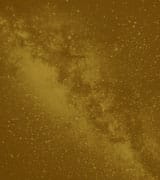Astronomical Ephemeris – December, 2021
Astronomical Ephemeris – December, 2021
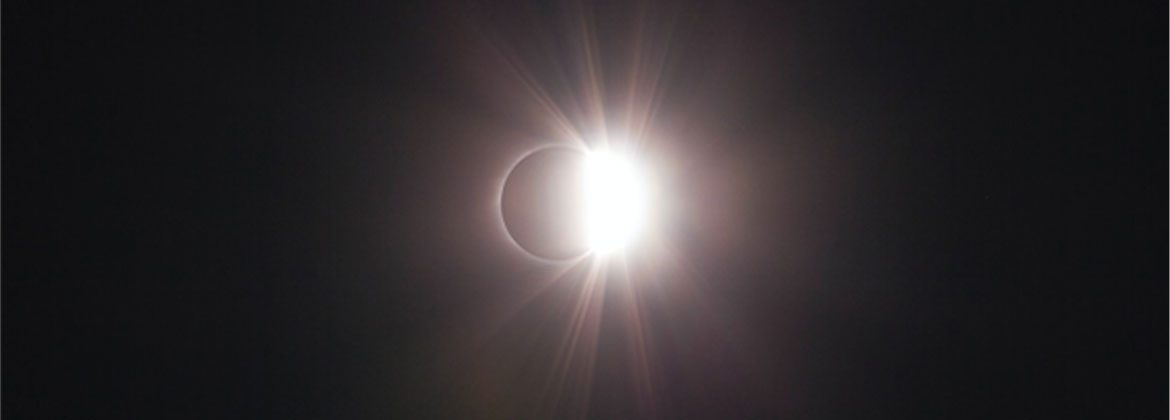

The astronomical ephemeris observable by the naked eye that we cover throughout the year, more than a guide to the events of the night sky, were an invitation and an inspiration to reflect on ourselves and our role in this world of which we are a part.
We were able to observe the celestial bodies fulfilling their cycles, without hesitation and without asking for anything in return, keeping the universe in balance and evolution.
Moon phases
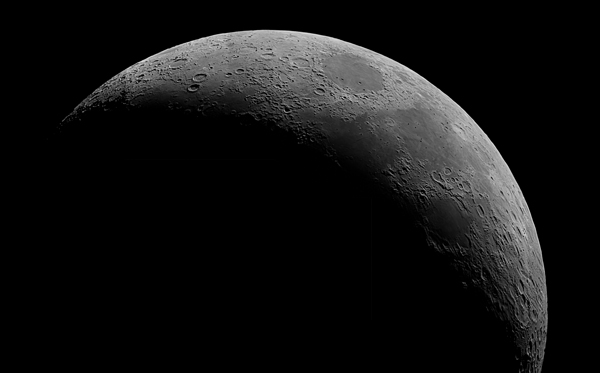
December 4 – New Moon
December 10 – First Quarter
December 19 – Full Moon
December 27 – Last Quarter
December 4
Total Solar Eclipse
On that day we will have the most prominent event to be observed in the December 2021 night sky, a total solar eclipse.
This eclipse can only be seen in its entirety in the extreme south of the planet, in Antarctica – best visibility in the Weddell Sea region – and part of the Atlantic, Pacific and Antarctic Oceans; and partially seen in a very small part of eastern Tierra del Fuego (Argentina) and southern Chile, the Falkland Islands, some points in Australia, New Zealand, South Africa and Namibia.
It will last 4 hours and 7 minutes – between 2:29 am and 6:36 am (Brasília -3UTC) – with the point of totality of the eclipsed Sun occurring for 1 minute and 54 seconds, starting at 4:34 am; to be seen at the very edge of the Antarctic continent, north of the Filchner-Ronne Ice Shelf.
The map below will guide you better.
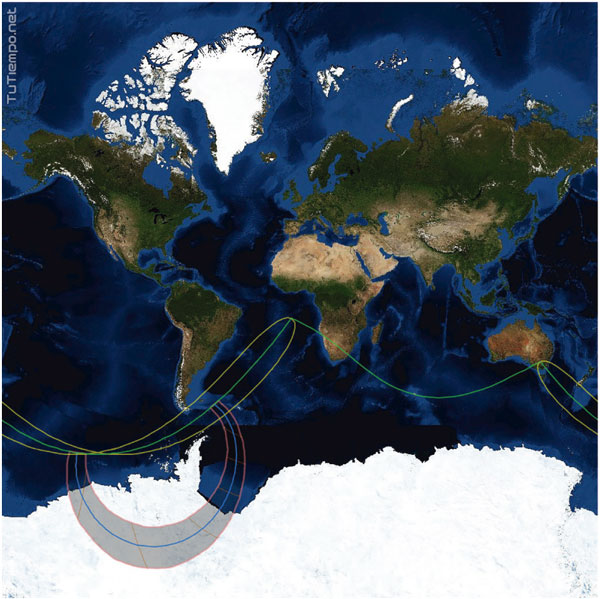
– the dark area with red lines around the edges and a central blue line represents the eclipse at totality
– the green lines indicate the beginning and/or end of the area where the eclipse can be partially observed
– the yellow lines indicate the star and end of visual contact of the moon and sun (start and end of the eclipse)
Talking a little about the geometry of the solar eclipse…
It always occurs at the new moon, when it is between the planet Earth and the Sun.
As a result of this Sun-Moon-Earth alignment, our satellite masks the sunlight for a brief period of time, casting a shadow on a small part of the Earth’s ground.
This shadow projected by the Moon is divided into “umbra”, a region where the Moon seems to completely cover the Sun’s light – total eclipse – and “penumbra”, a region where the Moon partially covers the Sun’s light – partial eclipse.
Eclipses can only be seen by those in the umbra and twilight regions.
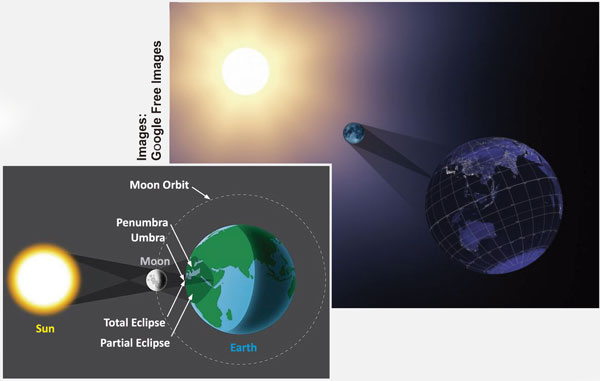
In a total solar eclipse, the sky is darkened as the Sun, Moon and Earth are aligned in the same direction – in a straight line – with the Moon apparently covering the entire solar disk, blocking its light.
Attention to the observation of this phenomenon…
You must not look directly at the Sun, eclipsed or not. UV radiation from the sun can cause serious or permanent damage to your eyes.
Therefore, the observation of solar eclipses requires care such as protective glasses or suitable equipment.
Conjunctions in December
Every month of the year, we have the opportunity to appreciate the “conjunction” phenomenon – an observer’s vision on terrestrial ground where two or more celestial bodies appear to be close together in the sky.
When the conjunction involves our satellite, the Moon, for those unfamiliar with the recognition of celestial objects, you can use it as a guide: …next to the Moon is the celestial object such and such…
In December the Moon will form conjunction with Venus, Saturn and Jupiter. So, get ready to locate and enjoy these planets in the December night sky.
Notes:
Although they are apparently very close together in the sky, the Moon and Venus, the Moon and Saturn and the Moon and Jupiter will not fit within a telescope’s field of view, so they can only be observed with the naked eye or binoculars.
And, the angulations and cardinal points mentioned here have the city of São Paulo/Brazil as a reference for the geographic coordinate of the observer’s position.
December 6
Conjunction between the Moon and Venus
On that day, the Moon will pass 1°52′ south of Venus, forming a conjunction with it, 32° (angle variable according to the geographic location of the observer) above the horizon line in the west direction, in the constellation Sagittarius.
They will be visible from 7 pm onwards and will remain observable in conjunction for approximately 3 hours when they will sink below the horizon at around 9 pm (Brasilia -3UTC).
The apparent brightness of the Moon at this time, for us here on Earth, will be magnitude -10.4 and Venus magnitude -4.7.
Observable around the world.
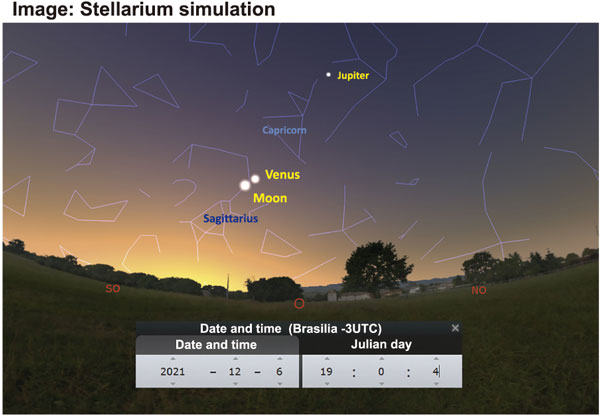
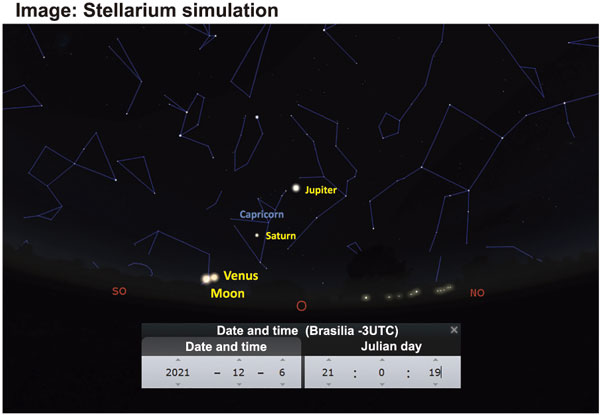
December 7
Conjunction between the Moon and Saturn
On the 7th, it will be the turn of the Moon and Saturn to form a conjunction, when it passes 4°11′ south of the planet with the beautiful rings.
From 7 pm (Brasilia -3UTC), 44° above the western horizon line (angle variable according to the geographic location of the observer), in the direction of the constellation Capricorn, the pair can be observed in conjunction, remaining visible until approximately 9:45 pm (Brasilia -3UTC), when it will sink below the horizon line.
The Moon will be at a magnitude (apparent brightness) of -11 and Saturn at 0.5.
Observable around the world.
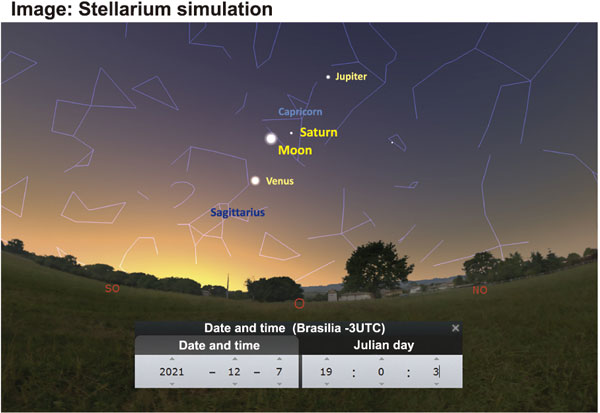
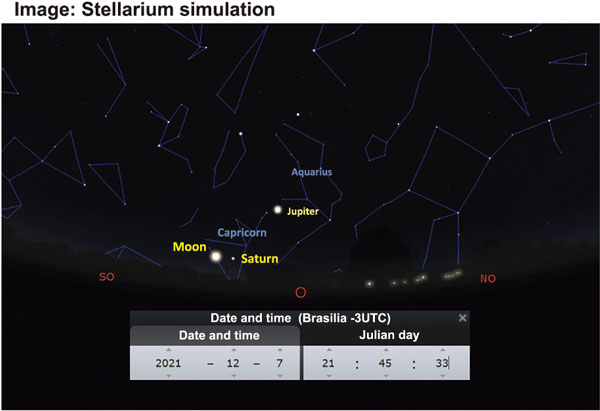
December 9
Conjunction between the Moon and Jupiter
On December 9th, the Moon will pass 4°28’ south of Jupiter, making a conjunction with the gas giant according to our angle of observation here on Earth.
The conjunction between them can be observed 56° above the western horizon line (angle variable according to the geographic location of the observer), in the direction of the constellation Aquarius, from 7 pm (Brasilia -3UTC).
They will be visible until approximately 10:30 pm (Brasilia -3UTC), when they will sink below the horizon line.
The Moon will be shining at a magnitude of -11.5 and Jupiter at a magnitude of -2.3.
Observable around the world.
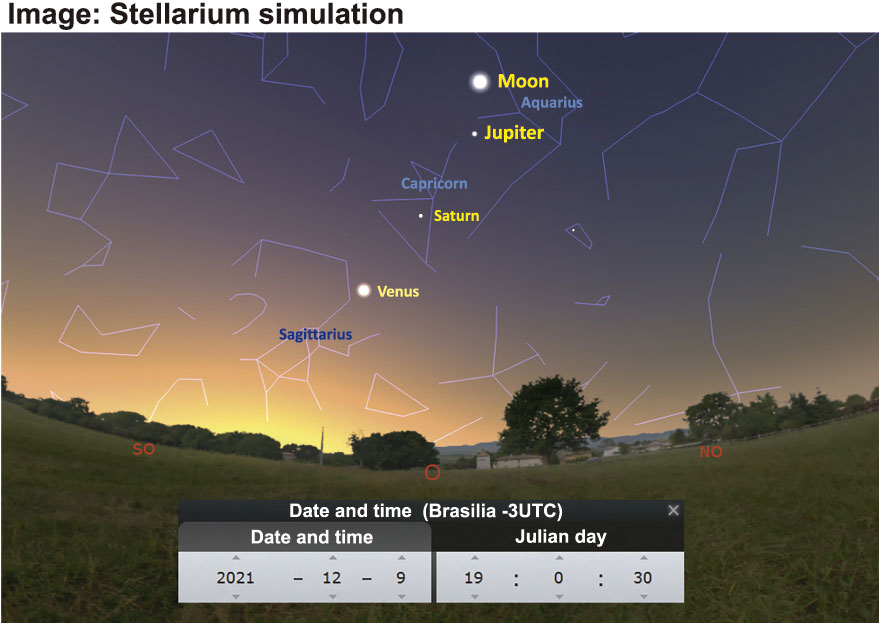
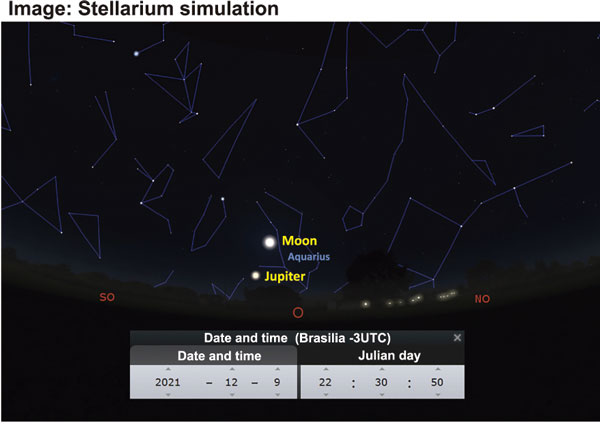
December 13 and 14
Geminids Meteor Shower
The Geminids, active from November 19 to December 24, are usually the most prolific, bright, and intensely colored meteor shower of the year.
This shower is due to the entry and burning in the Earth’s atmosphere of particles left by an asteroid – 3200 Phaethon – and not a comet, like the Quadrantids.
The asteroid 3200 Phaethon – believed to be rocky – takes about 1.4 years to orbit around the Sun. During this orbit it leaves debris trails in the cosmos and the Earth, during its orbit, ends up passing through this debris wake, which enter at an average speed (relative to other showers) in our atmosphere – about 35 km/s (21 miles/sec) – resulting in meteors that produce not long trails, but bright, colorful and easy to notice.
Geminids meteors seem to come from a radiant – apparent point of origin – in the constellation Gemini, hence its name. But they can appear anywhere in the sky.
Its peak – the moment of most intense activity – will be between the 13th and 14th, when it will produce an average rate, which will last several hours, of 50 to 120 meteors per hour.
In the southern hemisphere (south of the equator), its radiant, the constellation Gemini, rises around midnight, so the Geminids meteors can be seen from 9 pm (Brasilia -3UTC) with a peak around 2 am (Brasilia). -3UCT). In the northern hemisphere (north of the equator), the radiant rises soon after sunset, so meteors will be visible from late afternoon onwards, peaking around 11 pm (Brasilia -3UTC).
To observe the shower, the ideal is to look for a place with little or no light pollution, wait for your eyes to get used to the darkness – which should take 15 to 20 minutes – and look towards the radiant, the Gemini constellation. Now, just enjoy the show.
Note: On peak days the Moon is 77% full which may make meteor visibility somewhat difficult this year.
December 21
Southern Hemisphere Summer Solstice and Northern Hemisphere Winter Solstice
The solstices, like the equinoxes, also occur twice a year, with date variations – around June 21 and December – due to our planet’s elliptical orbit.
They are important in determining the summer and winter seasons in each hemisphere.
This is because…
Our planet rotates around its own axis – rotational movement (produces the “day and night” cycle) – which has an inclination of 23º27′ in relation to its rotation around the Sun – translational movement (produces the “year” cycle) – resulting in a different insolation – incidence of sunlight – in the hemispheres, that is, when there is more intensity in one hemisphere, there will be less intensity in the other.
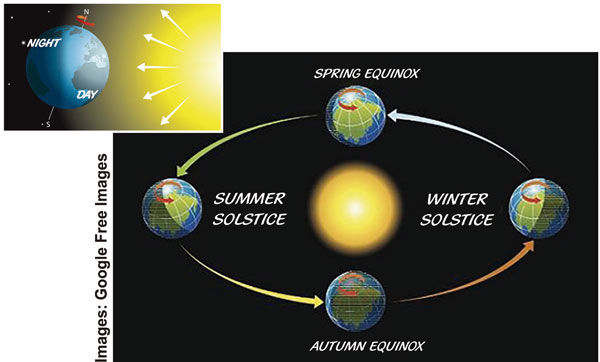
This means that the rotation and translation movements of our planet determine the distribution of sunlight between the hemispheres, resulting in longer days – summer – in the hemisphere in which the insolation is greater because it is more inclined towards the Sun and longer nights – winter – when the insolation is less because it is inclined away from the Sun.
In astronomical terms we say: “the times when the sun is furthest from the celestial equator are called the summer and winter solstices”.
On December 21, we will have the summer solstice in the southern hemisphere and winter solstice in the northern hemisphere.
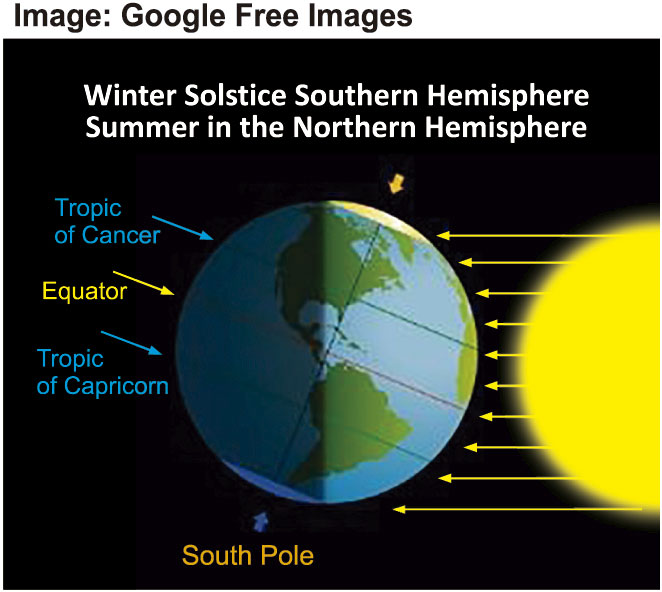
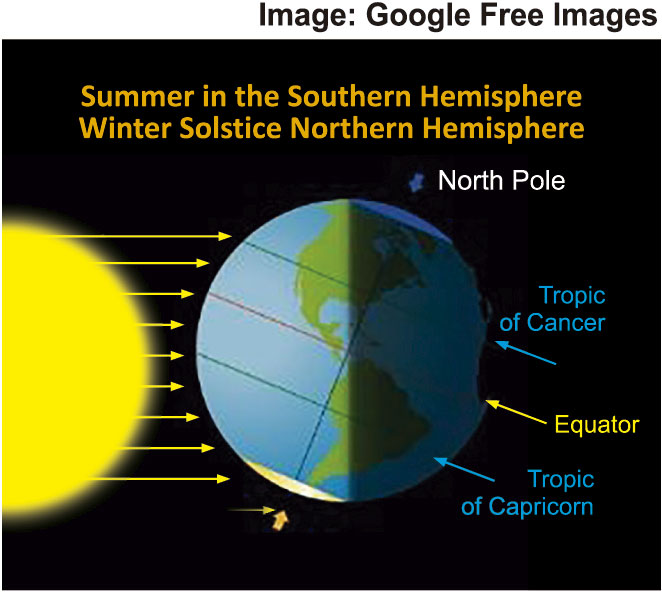
Sources: jpl.nasa.gov/calendar / solarsystem.nasa.gov / in-the-sky.org / Stellarium.org / earthsky.org / derekscope.co.uk / planetary ephemeris – Jet Propulsion Laboratory (JPL) / seasky. org / amsmeteors.org / rmg.co.uk / imo.net – International Meteor Organization
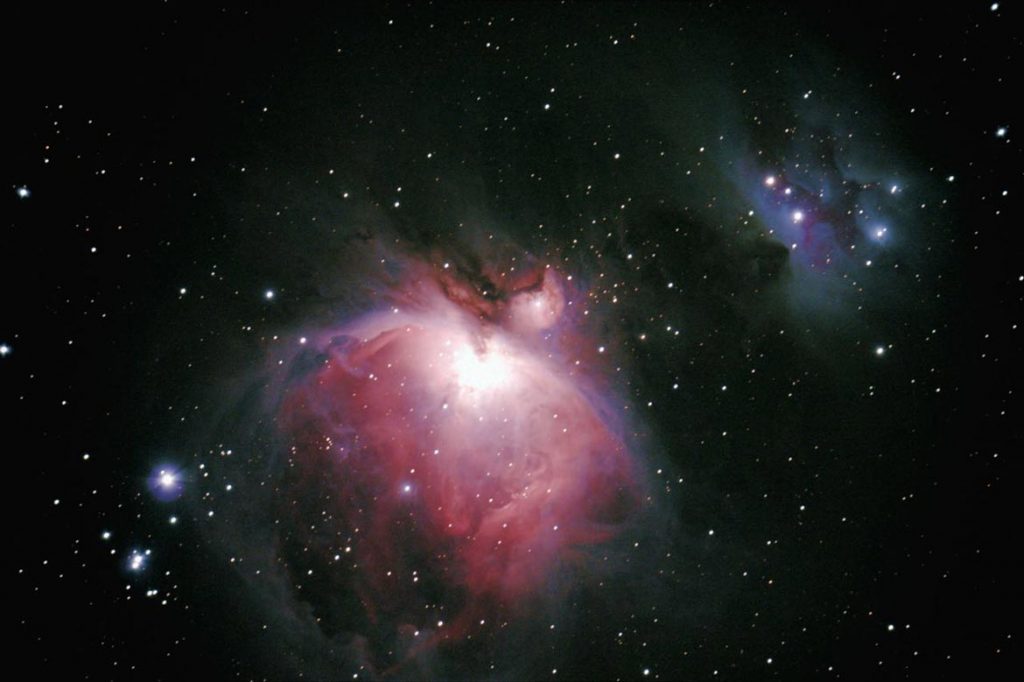
Astronomical ephemerides is a monthly calendar prepared by the Astronomy Sector, which is one of the 12 that make up the PRÓ-VIDA Laboratory Department. In the department, studies, research and scientific experiments related to various themes are developed, as well as field activities and lectures.

Astronomical ephemerides is a monthly calendar prepared by the Astronomy Sector, which is one of the 12 that make up the PRÓ-VIDA Laboratory Department. In the department, studies, research and scientific experiments related to various themes are developed, as well as field activities and lectures.

